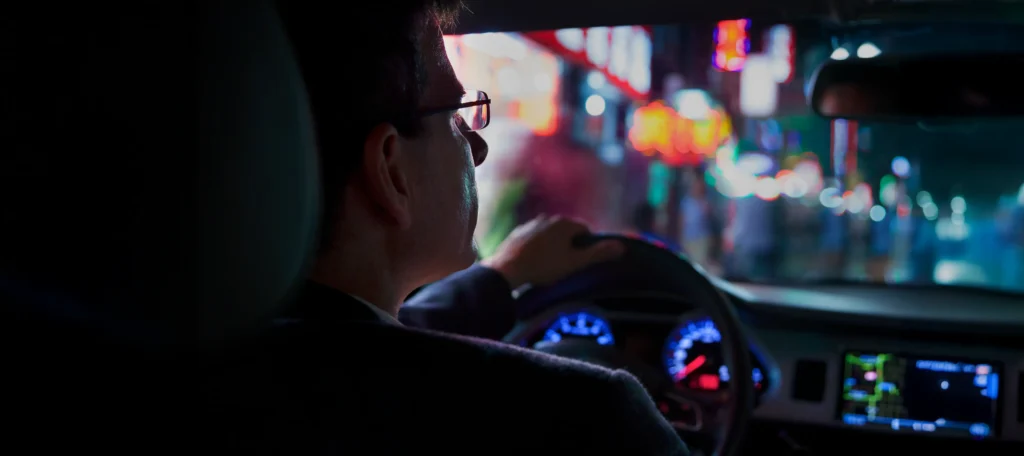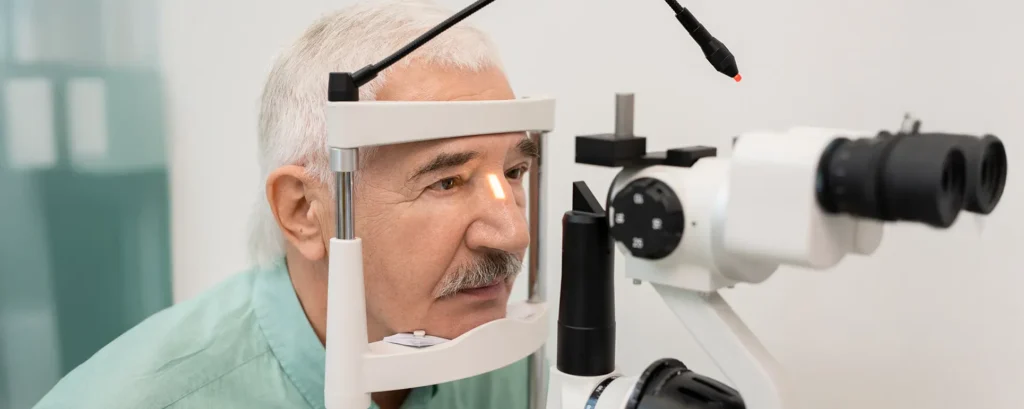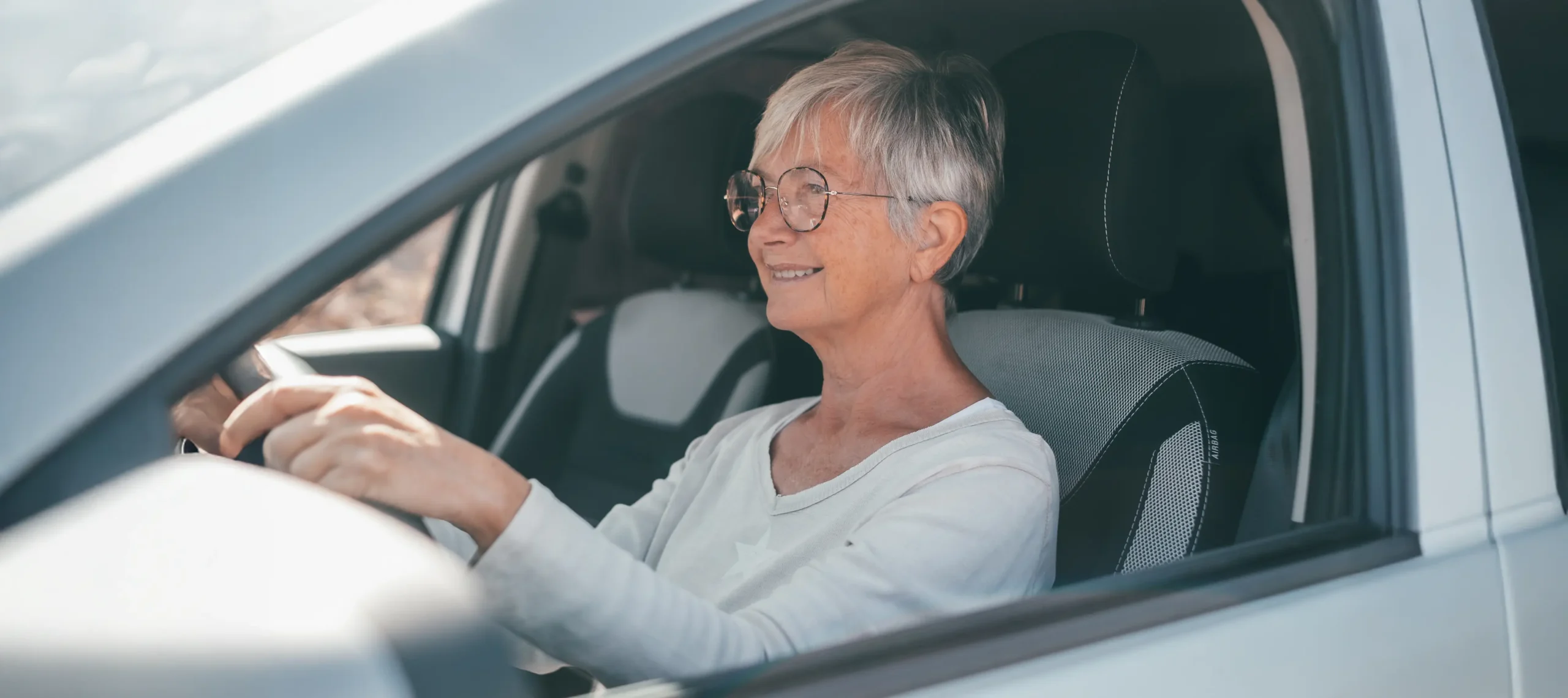If you’ve been diagnosed with cataracts and you drive, you’ve probably wondered what that means for your licence. Can you still drive safely? Are you breaking the law if your vision changes? And at what point do you need to tell the DVLA? These are questions many people never think about until they start noticing glare, halos, or blurriness behind the wheel. So, let’s break it all down in plain English.
This article explains exactly what the DVLA expects from drivers with cataracts, how the law works, and what steps you can take to stay legal and safe. We’ll also go through what happens if you’ve had cataract surgery, how the driving test for vision works, and when you might need to get your eyes checked again.
Understanding Cataracts and Why They Matter for Driving
Cataracts happen when the clear lens in your eye starts to become cloudy. It’s a natural part of ageing for many people, but it can also develop faster if you’ve had long-term sun exposure, diabetes, steroid use, or previous eye trauma. When this clouding progresses, your vision gradually loses sharpness and contrast.
That might not sound dramatic at first, but when you’re driving, even small visual changes make a big difference. Road signs can become harder to read, headlights from oncoming cars can scatter into glare, and your depth perception can change slightly. This can mean slower reaction times and reduced confidence—especially at night or in bright sunlight.
The DVLA’s main concern isn’t whether you have cataracts, but whether your eyesight still meets the legal standard to drive safely. In other words, it’s not the diagnosis that disqualifies you—it’s whether your vision allows you to drive without putting yourself or others at risk.
The DVLA’s Basic Eyesight Rules for UK Drivers

To drive legally in the UK, you must meet certain eyesight standards. These apply to all drivers, but they become particularly important if you have any eye condition like cataracts.
For Group 1 drivers (car and motorcycle licences):
- You must be able to read a vehicle number plate from 20 metres away in good daylight.
- Your visual acuity must be at least 6/12 (0.5 on the decimal scale) using both eyes together—or one eye, if that’s your only seeing eye.
- You must also have an adequate field of vision, meaning you can see enough of what’s happening around you to spot hazards to the sides as well as in front.
For Group 2 drivers (bus, coach, or lorry):
- You need sharper vision—at least 6/7.5 in your better eye and 6/60 in the other.
- Your visual field must be at least 160 degrees horizontally with no significant defect in the central 30 degrees.
You can wear glasses or contact lenses to reach these standards. The DVLA only cares about your corrected vision, not your natural eyesight.
So, if you pass the 20 metre number-plate test and meet the Snellen chart requirement, you’re generally fine to drive. But if cataracts start to blur your vision to the point where you no longer meet these standards, you’re legally obliged to stop driving until it’s corrected.
How Cataracts Affect Your Vision Behind the Wheel
Cataracts change the way light passes through your eye. Instead of a clear lens focusing light onto the retina, you have a cloudy one scattering it. That’s why you might notice:
- Blurry or foggy vision, even with your glasses on.
- Glare from headlights or sunlight that seems stronger than it used to.
- Halos or starbursts around lights at night.
- Reduced contrast, making it harder to distinguish objects in shadow.
- Difficulty seeing in dim conditions, such as early morning or twilight driving.
Even if your eyesight technically meets the DVLA’s minimum standard, these symptoms can still make driving uncomfortable and less safe. Many people notice that they stop driving at night altogether long before their cataract is “bad enough” for surgery.
Cataracts can also subtly affect depth perception and reaction time—both critical for judging distances when overtaking or parking.
When You Need to Tell the DVLA About Your Cataracts
You don’t have to tell the DVLA just because you’ve been diagnosed with cataracts. However, you must inform them if your cataracts (or any eye condition) affect both eyes and your vision doesn’t meet the minimum driving standard, even when wearing corrective lenses.
You also need to notify them if your doctor or optometrist advises that your vision is below standard or that continuing to drive could be unsafe.
If you fail to meet these requirements but continue driving without telling the DVLA, you could be fined up to £1,000 and face prosecution if you’re involved in an accident.
For many people, the trigger for contacting the DVLA comes after an optician’s check-up. If your optician finds your vision has dropped below the required level and can’t be corrected with glasses, you’ll need to stop driving until you’ve had treatment (usually cataract surgery).
How to Notify the DVLA About a Vision Problem

If you need to declare your cataracts to the DVLA, the process is fairly straightforward.
- Go to the DVLA website and search for the V1 form (for car or motorcycle drivers) or V1V form (for bus or lorry drivers).
- Fill in the form, explaining your diagnosis and what your current visual correction is (glasses, contact lenses, etc.).
- Send it to the address listed on the form.
- The DVLA may then ask for permission to contact your optician or ophthalmologist, or request that you take a vision test at an approved centre.
Once they review your case, they’ll decide whether you can continue driving, whether to issue you a short-term licence (typically one to three years), or whether you should stop until your vision is treated.
Cataract Surgery and Your Right to Drive Again
The good news is that cataract surgery usually restores your vision to well above the legal driving standard. Most patients achieve vision of 6/6 or 6/9 after surgery, depending on any other eye conditions they might have.
You can normally resume driving once:
- Your optometrist or surgeon confirms that your vision meets the legal standard, and
- You feel confident in your ability to see clearly in both daylight and at night.
There’s no fixed number of days you must wait after surgery—it depends on how your eye heals. Most people are cleared to drive within one to two weeks. However, if you’ve had surgery on both eyes close together, you’ll need to wait until both are sufficiently healed and stable.
It’s worth noting that after surgery, your vision may fluctuate slightly until your new glasses prescription is finalised. You should avoid driving until you can comfortably meet the 20 metre number-plate test without strain.
What Happens if You Don’t Meet the Standard
If your vision remains below the DVLA standard after surgery or your cataracts cannot be treated (for example, due to other eye problems), you won’t legally be able to hold a driving licence.
In this case, the DVLA may revoke your licence, but they’ll normally review your case again after a set period—especially if your doctor expects improvement.
For example, if you’re awaiting cataract surgery and your vision is temporarily below standard, your licence may be suspended rather than revoked. Once your surgery is complete and your vision is tested again, the DVLA can reinstate it quickly.
If your application is refused or withdrawn, you can appeal—but you’ll need recent ophthalmic reports showing measurable improvement in your sight.
Practical Tips for Safer Driving with Early Cataracts
If your cataracts are mild and you still meet the legal standard, you can continue driving safely with a few sensible precautions:
- Avoid night driving if glare from headlights becomes uncomfortable.
- Keep your windscreen spotless, as dirt and smears can worsen glare and blur.
- Get regular eye tests (at least every two years, or sooner if advised).
- Use polarised sunglasses during the day to cut glare and improve contrast.
- Drive slower in poor visibility and increase your following distance.
- Avoid long stints behind the wheel—fatigue worsens visual performance.
By being proactive, you can often continue driving confidently for years before cataract surgery becomes necessary.
Why Regular Eye Tests Matter More Than You Think
Many drivers assume their eyesight is fine until someone else points out the difference. Because cataracts progress slowly, it’s easy not to notice subtle declines in clarity or contrast.
Regular eye examinations can pick up early changes in lens opacity long before you experience major symptoms. This allows you to plan ahead—book surgery at a convenient time, and avoid a sudden stop-driving scenario.
Opticians can also measure whether your current visual acuity meets the driving standard. It’s a quick, inexpensive check that can save you a lot of stress later.
Insurance Implications of Driving with Cataracts
Your car insurance also depends on your legal fitness to drive. If you’re knowingly driving with vision below the DVLA standard, your insurer could refuse to cover you in the event of an accident.
Insurers typically expect you to have regular eye tests and to follow any medical advice regarding driving restrictions. Once your cataracts are treated and your sight improves, there’s usually no need to tell your insurer, but it’s wise to check the policy terms.
If the DVLA imposes temporary restrictions (such as a short-term licence), always inform your insurer—most are fine with it as long as you meet the driving standard.
DVLA Vision Testing: What to Expect
If the DVLA requests a visual assessment, you’ll likely be asked to attend a specialist vision testing centre. The test isn’t the same as your optician’s routine exam—it’s specifically designed to confirm whether you meet the legal standard for driving.
They’ll measure your visual acuity (how clearly you see letters on a chart), your field of vision (using a machine called a perimeter), and may test how well you can see in different lighting.
The results are sent directly to the DVLA’s medical group, who then make a decision. You’ll usually hear back within a few weeks.
FAQ Section
1. Do I need to tell the DVLA if I have cataracts?
Not necessarily. You only need to tell the DVLA if your cataracts affect both eyes and your vision no longer meets the required driving standard, even when wearing glasses or contact lenses. If your eyesight is still good enough to read a car number plate from 20 metres away and your optician confirms you meet the 6/12 vision requirement, there’s no need to notify them yet. However, if your cataracts worsen and your eyesight dips below this level, you must stop driving immediately and inform the DVLA. It’s always safer to check with your optician if you’re unsure.
2. Can I drive while waiting for cataract surgery?
You can continue driving while waiting for cataract surgery as long as your vision still meets the DVLA’s legal standard and you feel confident behind the wheel. Many people with early or moderate cataracts can safely drive during the waiting period, but it depends on the severity of your symptoms. If you notice glare, halos, or difficulty judging distances, it may be best to avoid driving, especially at night or in poor weather. If your optician advises that your sight is below the legal limit, you must stop driving until after your surgery and recovery.
3. How soon after cataract surgery can I drive again?
Most people can drive again within one to two weeks after cataract surgery, provided their vision meets the DVLA’s requirements and they feel comfortable doing so. You should wait until your surgeon or optometrist confirms that your eyesight is clear enough and stable enough for driving. Don’t rush it—some people heal faster than others, and your depth perception may take a few days to readjust. It’s best to try reading a number plate from 20 metres in daylight before getting back behind the wheel. Once you’re confident, you can resume driving safely.
4. Will the DVLA revoke my licence if I have cataracts?
No, the DVLA doesn’t automatically revoke your licence just because you’ve been diagnosed with cataracts. What matters is whether your vision still meets the legal standard. If your eyesight falls below the required level, the DVLA may temporarily suspend your licence until your vision improves, usually after surgery. In most cases, once your eye surgeon confirms that you’ve regained sufficient vision, your licence can be reinstated without issue. The DVLA’s goal isn’t to penalise drivers—it’s to ensure safety for you and others on the road.
5. Can I still drive at night with cataracts?
It depends on how your cataracts affect you. Many people find night driving difficult because of glare from headlights and reduced contrast in low light. If you start seeing halos around lights, or struggle to see pedestrians or road signs clearly, it’s best to limit or avoid driving at night. While this isn’t a legal requirement, it’s a sensible precaution. If your vision feels unsafe under those conditions, it’s a sign your cataracts may be worsening and it’s time for another eye check-up.
6. What happens if I don’t tell the DVLA about my vision problem?
If you continue driving with vision below the DVLA’s required standard and fail to notify them, you could face serious consequences. You risk a fine of up to £1,000, potential prosecution if you’re involved in an accident, and your car insurance could become invalid. The DVLA relies on drivers to self-report eyesight issues, so it’s your legal responsibility to inform them if you’re unfit to drive. It’s far better to be honest and take a short break from driving than to risk losing your licence or insurance cover.
7. Do cataracts affect my car insurance?
Yes—indirectly. If you’re knowingly driving while your eyesight is below the DVLA standard, your insurer could refuse to pay out in the event of an accident. However, if your cataracts are mild and you meet the legal requirements, there’s no problem. Once you’ve had cataract surgery and your vision improves, you don’t usually need to inform your insurer. The key thing is to be truthful: if the DVLA restricts your licence temporarily or you’re advised not to drive, you must let your insurer know to keep your cover valid.
8. Can glasses or contact lenses correct vision affected by cataracts?
In the early stages, yes—glasses or contact lenses can help sharpen your vision by compensating for refractive changes caused by the developing cataract. However, as the lens becomes cloudier, optical correction stops being effective because the blur isn’t caused by the shape of your eye—it’s caused by light scattering within the lens itself. When this happens, surgery becomes the only way to restore clear vision. After surgery, many people find they need weaker prescriptions or no glasses at all for distance vision.
9. How often should I have my eyes tested if I drive?
If you drive regularly, it’s best to have an eye test at least every two years—and annually once you’re over 60 or if you’ve been diagnosed with cataracts. Regular testing ensures that any gradual decline in your vision is detected early, before it becomes a safety issue. Opticians can check your visual acuity, contrast sensitivity, and glare tolerance—all of which matter for driving. Think of it like servicing your car: it’s routine maintenance for your eyesight that keeps you safe and legally compliant.
10. Can I appeal if the DVLA says I can’t drive?
Yes, you can appeal the DVLA’s decision if you believe your eyesight has improved or was incorrectly assessed. To do this, you’ll need recent medical evidence—usually an optometrist or ophthalmologist’s report showing that you now meet the legal driving standard. Appeals can be made through the DVLA’s official process, and many drivers successfully regain their licences after cataract surgery or further eye treatment. The key is to provide clear clinical proof of your vision levels and follow all requested testing promptly.
Final Thoughts
Driving is a vital part of independence for many people, and developing cataracts doesn’t necessarily mean losing that freedom. What matters most is staying aware of how your vision changes and following the DVLA’s requirements honestly.
If your eyesight ever dips below the legal standard, stop driving, get your eyes checked, and discuss options with your optometrist or ophthalmologist. Most people regain excellent driving vision after cataract surgery and return to the road with even clearer sight than before.
If you’re unsure about your vision or want expert advice, you can always speak to the team at London Cataract Centre—they specialise in safe, effective cataract surgery using advanced lens options to restore clear vision and help patients get back to the activities they love, including driving.
References
- GOV.UK. (2024) Driving eyesight rules. [online] Available at: https://www.gov.uk/driving-eyesight-rules [Accessed 31 Oct. 2025].
- NHS. (2023) Cataract surgery – Recovery and returning to normal activities. [online] Available at: https://www.nhs.uk/conditions/cataract-surgery/recovery/ [Accessed 31 Oct. 2025].
- Moorfields Eye Hospital NHS Foundation Trust. (2023) Vision and driving FAQs. [online] Available at: https://www.moorfields.nhs.uk/for-patients/information-hub/vision-and-driving-faqs [Accessed 31 Oct. 2025].
- Royal College of Ophthalmologists. (2023) Cataract and driving guidance for patients. [online] Available at: https://www.rcophth.ac.uk/patients/ [Accessed 31 Oct. 2025].

